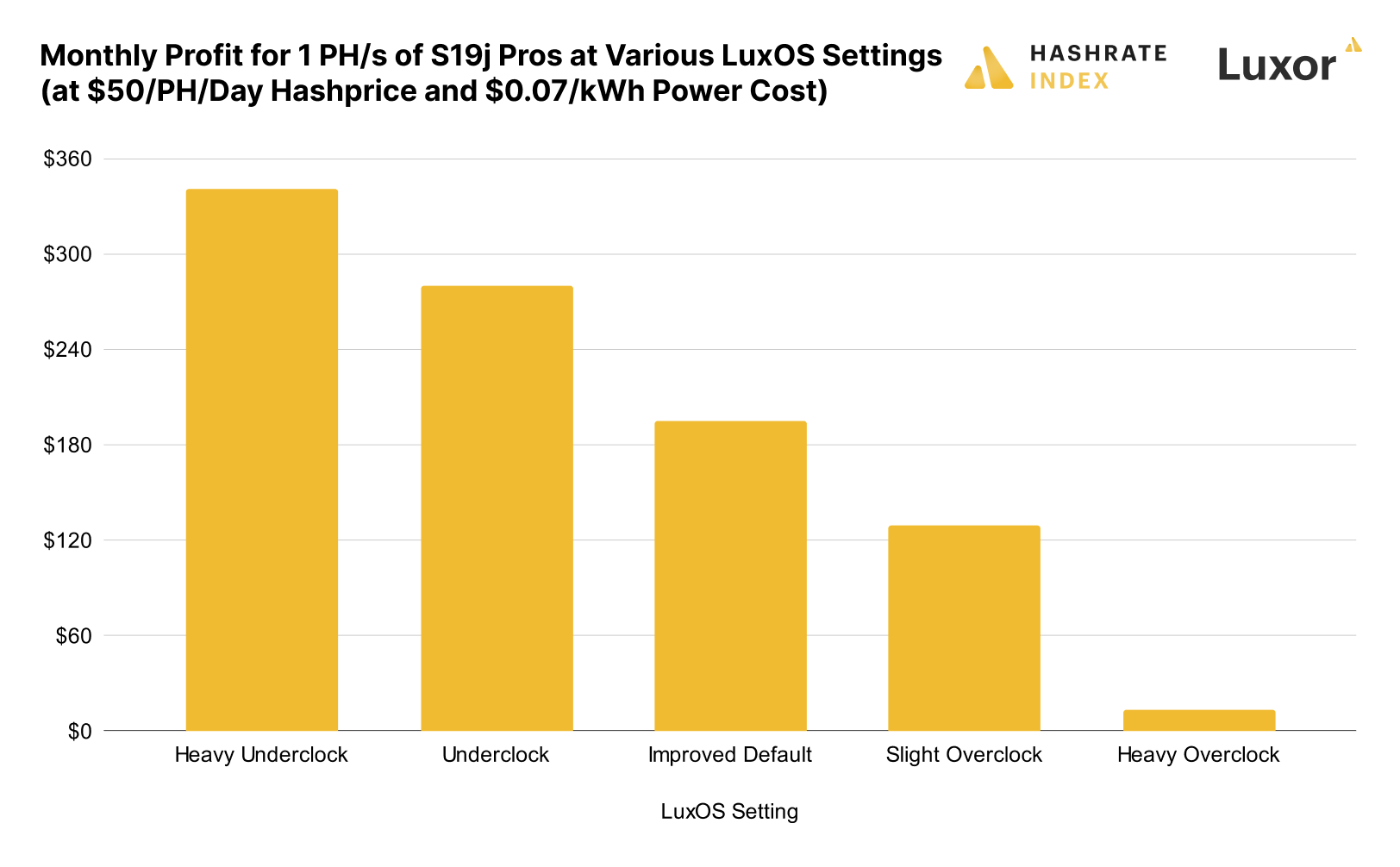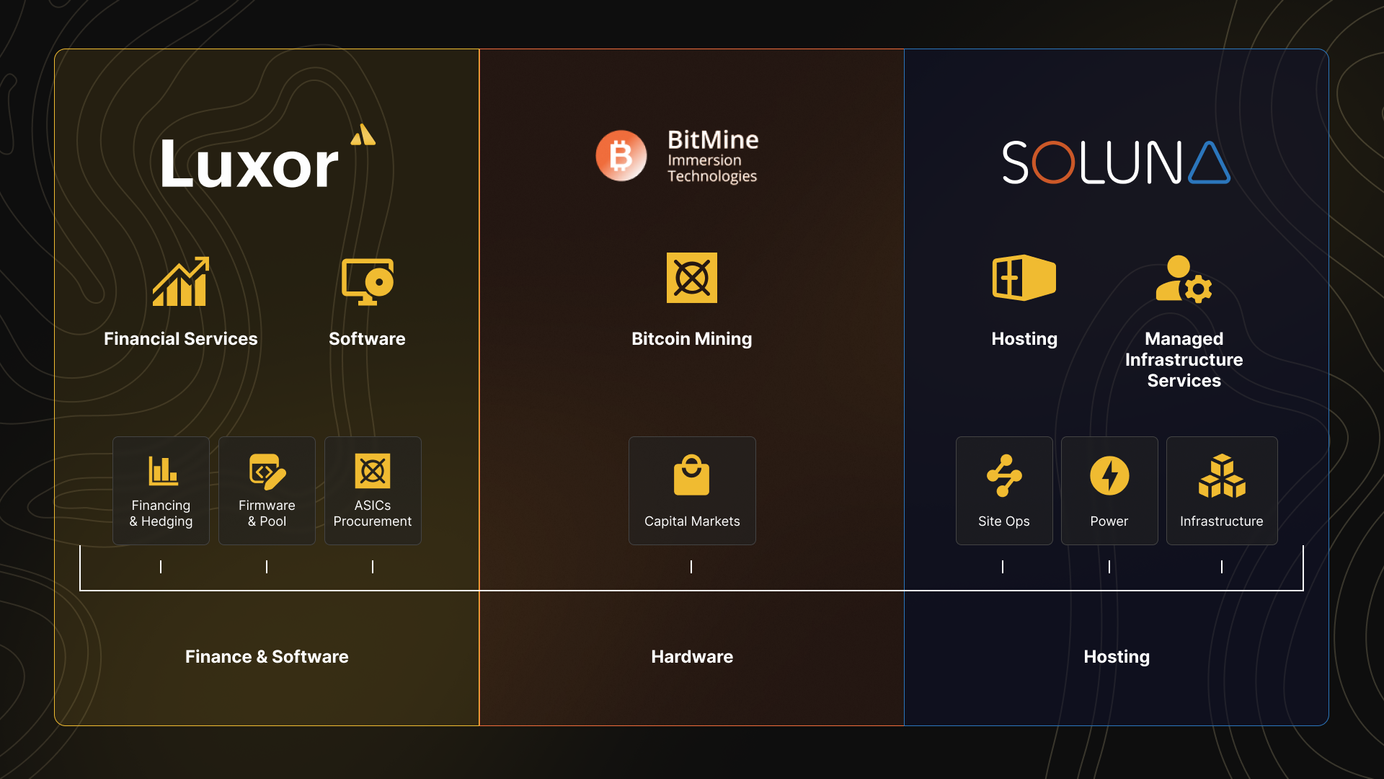
How Underclocking ASICs With LuxOS Can Help Hosts and Clients in Low Hashprice Environments
When hashprice is low, LuxOS can give hosted miners the boost they need to stay in the game.
The Fourth Bitcoin Halving has come to pass, and hashprice is the worse for it. With Bitcoin mining profit margins compressed, Bitcoin miners around the world are searching for ways to cut cost and boost efficiency. Improving an ASIC fleet’s efficiency could mean buying new equipment, but there’s a more affordable method to do this without spending CAPEX on new machines: running after-market firmware.
After-market firmware like LuxOS can help miners increase their profit margins by improving their ASIC fleet’s efficiency. For hosting providers specifically, operating Firmware on behalf of their clients can help retain those clients that are near breakeven or underwater.

How Underclocking With LuxOS Can Help Hosting Providers Retain Clients
Let’s assume that a Bitcoin mining hosting provider has the following:
- 1 MW of hosted miners.
- Hosting Provider charges 0.07/kWh to their clients to host and operate their ASICs
Half of the host’s clients have next generation ASICs like the S21 and M60, so they are still mining with comfortable margins. But the other half has older generation machines like the S19j Pro with an average efficiency of 31 J/TH. These 31 J/TH rigs have a hashcost of $52.08 per day, so assuming a hashprice of $50/PH/Day, they would be unprofitable in this scenario. As such, the host is in danger of losing half of its clients to unprofitability. When a hosted clients ASICs become unprofitable, clients generally have 3 options depending on their contract:
- Continue to mine unprofitably: This can be a viable strategy, but the miner is taking a longer term view that the Bitcoin price will increase and that Bitcoin mined at a premium today will be worth more in the future.
- Turn off their ASICs: Turning off ASICs for hosted clients can be difficult as it is subject to their hosting contract and other considerations.
- Use aftermarket firmware: If these hosting clients were optimizing their ASICs with LuxOS, however, they could take their profit margins from negative to 25% by underclocking to improve efficiency.

It’s important to note that this strategy works well to keep hosted clients hashing and profitable, however from the hosting providers perspective, it adds complexity to their hosting revenue. The primary function of a hosting provider is to provide electricity and maximize a miner’s uptime. To take a step back, hosting providers invoice their clients in a few different ways:
Good
- Metered (per container): Hosts measure power consumption at the container level, and they make further calculations to offset the cost of operating auxiliary infrastructure (fans, other cooling devices, etc).
Better
- Nameplate Power Consumption: Hosting providers will bill based on the nameplate power consumption of the miner minus any hours of downtime. This can be misleading and inaccurate as an ASIC miner’s power consumption can fluctuate between day or night as well as seasonally, which can result in overbilling.
Best
- Metered (per miner): Hosts can measure accurate power draw from each ASIC miner’s power distribution units (PDU’s), which creates the most accurate invoicing for hosted clients.
Back to our scenario, clients who underclock are consuming less power to maximize margins in a low hashprice environment. While this is great for the individual miner, this ultimately decreases the hosting provider revenue since the miner is consuming less electricity. Since the providers’ full power capacity is being underutilized this leads the Hosting provider to explore three scenarios:
- Overclock profitable miners
- Backfill rackspace/underutilized power with additional underclocked miners.
- Upsell clients the newest generation of miners
The aforementioned scenarios would help hosting providers maintain the revenue levels they earned before their clients underclocked with LuxOS. But it’s worth noting that, in some cases, the hosts would lose out on all revenue from these clients if their ASICs become unprofitable and they unplug them.
Other Benefits of LuxOS for Hosts
LuxOS can provide additional benefits to hosts that go beyond optimizing client rigs to ensure client retention.
For example, some hosting providers might allot hosting contracts and keep tabs on their MW under management based on the nameplate hashrate of the rigs that they host. The nameplate power draw that manufacturers report per model is often more or less than the rig’s actual power draw.
LuxOS can help hosts measure actual power draw more accurately to improve their billing. The LuxOS dashboard provides estimates for each rig’s power draw within 3% of the nameplate power consumption. However the S21 and T21 series of miners provide exact power consumption since Bitmain released a power meter inside the power supply unit (PSU). As such, hosts can couple this data with the LuxOS API to accurately bill clients.
Bottom Line: LuxOS Is a Fast-Fix for Improving Bitcoin Mining Margin
After-market firmware acts as an alternative to the default firmware from manufacturers that comes preloaded onto Bitcoin mining ASICs. After-market firmware comes from third party companies and typically provides miners with better tooling over their ASICs by giving them greater control over the electricity draw of the ASIC’s hashboards.
Controlling the ASIC’s voltage and chip frequency controls the ASIC’s hashrate; increasing frequency of the chip, will require more voltage (power), which increases hashrate, this is known as overclocking, while reducing voltage and chip frequency consumption and thus decreasing the ASIC’s hashrate is called underclocking.
In low hashprice environments, underclocking can help miners improve their margins, even flipping otherwise negative margins into positive ones. This is especially helpful for older, less efficient ASICs, but firmware can also improve the margins of newer models by optimizing their energy efficiency.
Indeed, when we observe operating margins at current hashprice levels when running an ASIC at default settings versus optimized settings with LuxOS, it becomes clear that miners can improve their operations with after-market firmware. Even next-gen machines like the S21 and S19 XP can earn more when optimized with LuxOS, while older models like the S19 and S19j Pro (which are unprofitable at average power costs with default settings enabled) can turn a profit when underclocked with LuxOS.
Hosting providers should be incentivized to adopt firmware strategies for both the good of their clients and for themselves. Indeed, after-market firmware like LuxOS provides a win-win for clients by improving their margins and for hosts who would lose these clients if not for the improvements to energy efficiency.
Hashrate Index Newsletter
Join the newsletter to receive the latest updates in your inbox.







